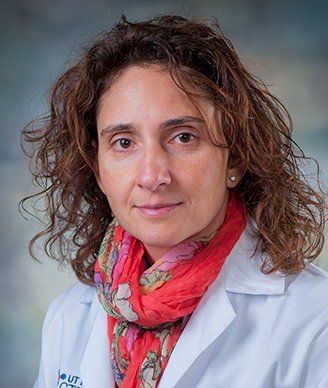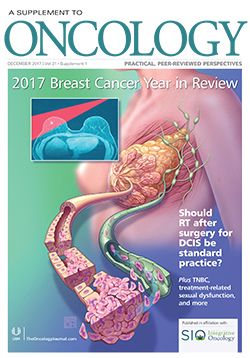Developments in Breast Cancer 2017–2018: New Drugs, New Drug Classes-and the Prospect of More to Come
This interview provides perspective on developments in breast cancer treatment in 2017, as well as a preview of what we can expect to change in the treatment of breast cancer in 2018.
Virginia G. Kaklamani, MD, DSc

This interview provides perspective on developments in breast cancer treatment in 2017, as well as a preview of what we can expect to change in the treatment of breast cancer in 2018-including changes likely to result from studies presented at the San Antonio Breast Cancer Symposium. Dr. Kaklamani leads the Breast Cancer Program, where she cares for patients and conducts research on genetic mutations that are associated with an increased risk for breast and other types of cancer.
1.Was there anything especially exciting that happened in 2017 as far as new drug approvals for breast cancer, new approaches to diagnosis and care, or advances in our understanding of the biology of breast cancer that you can highlight?
DR. KAKLAMANI: Absolutely. This year there were a few noteworthy things that happened. We have the new CDK4/6 [cyclin-dependent kinase 4/6] inhibitors approved for treatment of metastatic breast cancer. These drugs have improved progression-free survival in women who have metastatic estrogen receptor (ER)-positive breast cancer. One of these CDK4/6 inhibitors-palbociclib-had been approved previously, but two additional ones-ribociclib and abemaciclib-were approved this year, and these are all currently being used as the standard of care in the first- or second-line setting in metastatic ER-positive breast cancer. Additionally, a medication called neratinib, which is an anti-HER2 [human epidermal growth factor receptor 2] tyrosine kinase inhibitor, was approved for women with early-stage HER2-positive breast cancer who have completed a year of trastuzumab therapy; neratinib was shown to improve disease-free survival in this setting. We’ve also had clinical trials that were presented that will lead to more approvals at the beginning of next year. As for new approaches to diagnosis, 3D mammograms are becoming a little bit more mainstream: several states are now using 3D mammograms as a standard screening modality, and new clinical trials are addressing whether the outcomes will be better with 3D mammograms compared with regular mammograms.
2.Are there any trial results or other important studies from the San Antonio Breast Cancer Symposium that you think might be practice changing?
DR. KAKLAMANI: Definitely. We are celebrating our 40th anniversary this year, so this is kind of a big symposium for us. There are several trials that are looking at immunotherapy in combination with chemotherapy, as well as other targeted therapies, for the treatment of not only triple-negative breast cancer but also other types of breast cancer. These are still considered preliminary results; I don’t think that there will be approvals based on these trials, but we will be able to design the next set of trials, which will lead to approvals of agents in this class in metastatic breast cancer.
There is another large trial that is looking at a PARP [poly (ADP-ribose) polymerase] inhibitor called talazoparib, and that trial will be in women who have mutations in BRCA1 or BRCA2 genes. This trial will look at whether talazoparib is active in metastatic breast cancer in this patient population. Earlier this year, data for another PARP inhibitor-olaparib-showed that this agent was preferable to standard-of-care chemotherapy in patients with metastatic disease. So, it will be exciting to see what will happen with talazoparib. This class of drugs has been studied for a few years in breast cancer, and we are now seeing the large phase III trials looking at whether they are active enough to warrant approval.
There are also some trials in early breast cancer looking at COX-2 [cyclooxygenase-2] inhibitors and bisphosphonates, as well as how long we should be giving endocrine therapy to women with early-stage breast cancer. A big emphasis at this conference every year is on preclinical work. How do we understand the biology of breast cancer better? How do we pick drugs based on subtypes of breast cancer-not just the ER, PR [progesterone receptor], and HER2 subtypes, but more molecularly based subtypes? And then, finally, how do we assess and predict response based on biomarkers? There are quite a few abstracts on biomarker response that I think are exciting.
3. As a look ahead to next year, what are some of the important trial results that we might see in 2018?
DR. KAKLAMANI: One of the trials whose results we have been looking forward to for a while is called TAILORx. This is a trial that is looking at early-stage breast cancer and whether chemotherapy can be avoided in a subgroup of women with a genomic profile that is not aggressive. TAILORx had some results presented a year and a half or so ago, and now we are waiting for results from the main subgroup of patients. We thought part of the trial data would be presented this year but it wasn’t. I think that at some point next year we’ll have results. We will also have results from some of our immunotherapy trials, probably at the end of next year, which will shed some light on these agents that have been shown to be active in many cancers-such as lung cancer, melanoma, and bladder and kidney cancer-and will show whether they are also active in breast cancer. In addition, some of the other PARP inhibitor trials will be maturing, as well as some of the PI3K [phosphoinositide 3-kinase] inhibitor trials-the PI3K inhibitors have shown activity in a subset of ER-positive breast cancers that have mutations in PIK3CA. I think for next year, those are the big trials to look for.
4. Lastly, are there any new modalities or combination therapies that are being studied in breast cancer that may be particularly interesting or promising that you can highlight?
DR. KAKLAMANI: I think I’ve mentioned some of them in my previous remarks. The first one is PARP inhibitors. I think at the beginning of next year, one of the PARP inhibitors will be approved, and by the end of the year, there will maybe be two PARP inhibitors approved. Those are going to be initially approved in a very small subset of breast cancer patients who are BRCA1- or BRCA2- positive, but we are looking at them in other subsets of breast cancer patients as well, so stay tuned for that. PI3K inhibitors are another class of agents that have shown promise, with some of the results presented last year and some presented this year. The next large set of trials are looking at the immunotherapeutic drugs and how to combine them with other agents. Our initial thought was to combine them with chemotherapy, but there might be other combinations out there, such as with PARP inhibitors, which might be more promising than just combining them with chemotherapeutic drugs.
Financial Disclosure: The author has no significant financial interest in or other relationship with the manufacturer of any product or provider of any service mentioned in this article.
Newsletter
Stay up to date on recent advances in the multidisciplinary approach to cancer.
